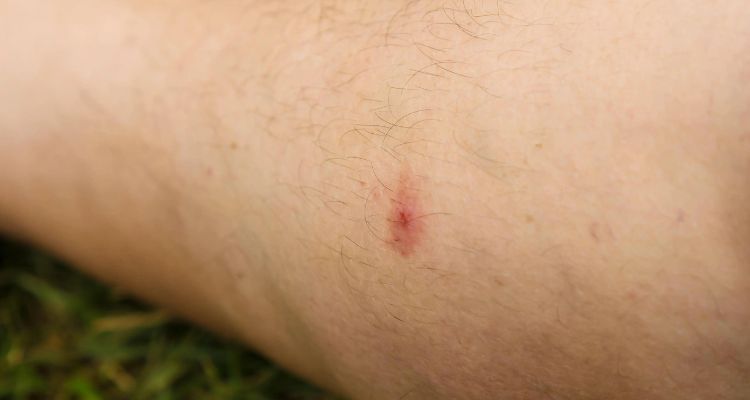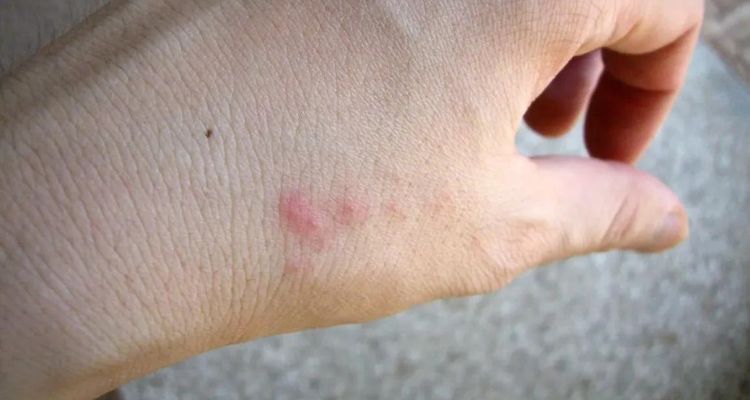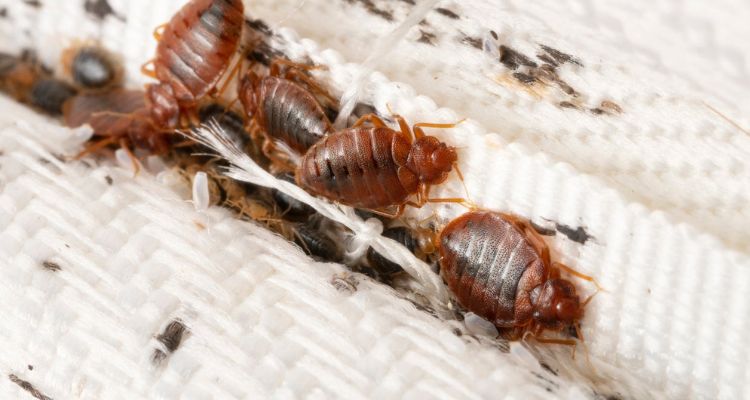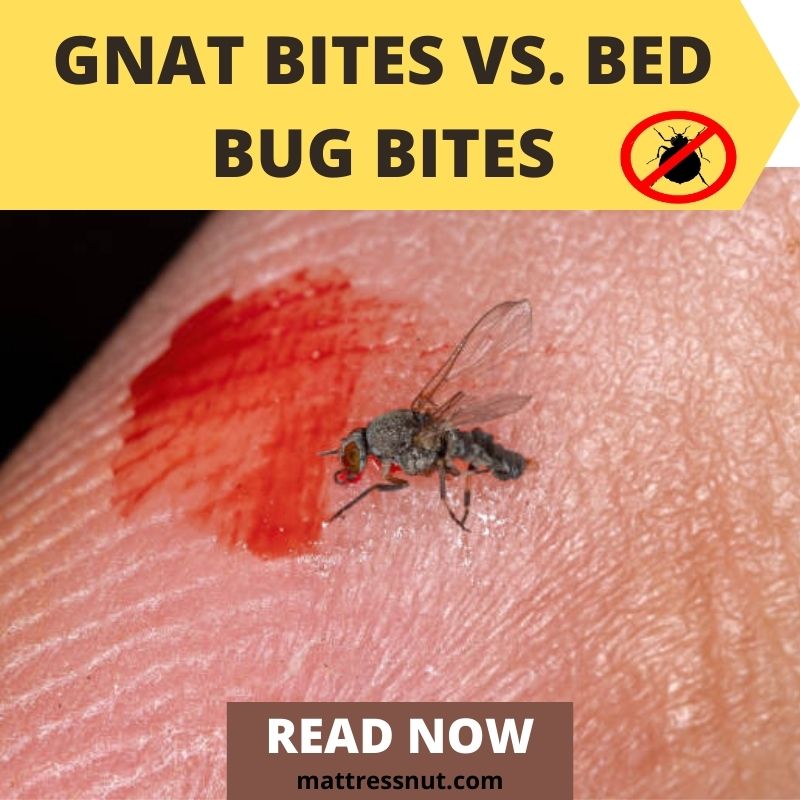Itchy bug bites are an all-too-common annoyance during the warmer months, but not all bites are created equal. Gnat bites and bed bug bites may seem similar at first glance, but understanding their differences is crucial for effective treatment and prevention.
In this post, we will delve into the distinct characteristics of gnat and bed bug bites, helping you identify the culprit when you find yourself scratching those pesky red welts.
Armed with this knowledge, you’ll be better equipped to deal with the discomfort and take the necessary steps to protect yourself from these tiny, biting nuisances.
Gnat Bites
Description of gnat bites, including appearance and common locations:
Gnat bites typically appear as small, red, and raised bumps on the skin. They are commonly found on exposed areas such as arms, legs, and neck. Unlike mosquito bites, gnat bites often manifest in clusters.

Characteristics of the itching and discomfort associated with gnat bites:
Gnat bites are notorious for their intense itching. The discomfort usually arises within minutes and can persist for several days. Scratching can lead to infection, making prompt relief essential.
Overview of the types of gnats that bite humans:
Various types of gnats, like black flies and sandflies, are known to bite humans. They’re attracted to sweat and carbon dioxide, making outdoor activities prime times for gnat encounters.
Bed Bug Bites
Description of bed bug bites, including appearance and common locations on the body:
Bed bug bites appear as small, red, itchy welts. They commonly occur in a linear or zigzag pattern on areas of the body exposed during sleep, such as the face, neck, arms, and back.

Characteristics of the itching and discomfort associated with bed bug bites:
Bed bug bites often cause intense itching and may lead to secondary skin infections due to scratching. Some individuals may not immediately react to bed bug bites, making detection challenging.
Explanation of the life cycle and habits of bed bugs:
Bed bugs are nocturnal pests that feed on human blood. They hide in cracks, crevices, and mattresses during the day, emerging at night to bite and feed. Their life-cycle consists of egg, nymph, and adult stages, with females laying multiple eggs daily, making infestations hard to eradicate.
Key Differences in Appearance
Visual comparison of gnat bites and bed bug bites, including size, color, and pattern:
Gnat bites are generally smaller and appear as tiny red bumps, often clustered together. Bed bug bites are slightly larger, with a reddish center and a pale, swollen area surrounding them. They may appear in a linear or grouped pattern.
Highlighting distinctive features such as the appearance of the bite mark and surrounding area:
Gnat bites are smaller and more uniform in size, whereas bed bug bites often have a larger, raised center and surrounding redness. Bed bug bites can resemble a small, itchy blister.
Location of Bites
Discussion of the typical locations on the body where gnat bites occur:
Gnats tend to target exposed skin, so you’ll commonly find their bites on your arms, legs, neck, and face, especially in outdoor settings.
Explanation of the areas where bed bug bites are commonly found:
Bed bug bites are typically found on areas that contact bedding or clothing during sleep. They favor the face, neck, arms, and back. Linear patterns in these regions may suggest bed bug infestations.

How the location of the bites can be a significant clue in differentiation:
The location of the bites can offer valuable clues. Gnat bites are usually on exposed skin, whereas bed bug bites cluster around areas where skin contacts bedding, making the positioning of the bites an important factor in differentiation.
Symptoms and Sensations
Detailed explanation of the itching and discomfort experienced with gnat bites:
Gnat bites elicit immediate, intense itching and discomfort due to their saliva being injected during feeding. Scratching can break the skin, increasing the risk of infection. Some individuals may experience mild swelling and redness.
Description of the itching and skin reactions commonly associated with bed bug bites:
Bed bug bites often delay itching, typically from hours to days after the initial bite. They cause localized redness, swelling, and intense itching, sometimes leading to allergic skin reactions and secondary infections.
How the sensation and severity of symptoms can differ between the two types of bites:
Gnat bites provoke instant and sharp itching, while bed bug bites offer a delayed but persistent itch. The severity of symptoms can vary widely among individuals, making the timeline and location of the bites crucial for differentiation.
Timeline and Progression
Overview of the timeline of gnat bites, from initial bite to reaction:
Gnat bite symptoms usually appear immediately after the bite, peaking within hours. They subside within a few days as the body’s immune response diminishes, leaving behind small red bumps.
Explanation of the delayed reaction often seen with bed bug bites:
Bed bug bites often have a delayed onset, with symptoms emerging hours to days later. The itching and skin reactions may intensify over time, making it challenging to connect with the actual bites.
How understanding the progression can help in differentiation:
Understanding the timeline can aid in differentiation. Gnat bites are more likely if symptoms develop instantly and are clustered on exposed skin. Delayed itching, especially in patterns on areas exposed to bedding, may point to bed bug bites, necessitating a closer inspection of your sleeping quarters.
Treatment and Prevention
Recommended treatments for gnat bites, including over-the-counter remedies:
Over-the-counter hydrocortisone creams and antihistamines can help reduce itching and inflammation to alleviate gnat bite symptoms. Applying cold compresses and keeping the area clean can also provide relief.
Strategies for preventing gnat bites, such as using insect repellent and wearing protective clothing:
Prevent gnat bites by wearing long-sleeved clothing, using insect repellent containing DEET, and avoiding outdoor activities during peak gnat activity times, usually at dawn and dusk.
Bed bug bite treatment options and measures to prevent bed bug infestations:
Bed bug bites often require only symptomatic relief, such as topical corticosteroids for itching. To prevent infestations, inspect and vacuum your bedding and furniture regularly. If you suspect a bed bug infestation, promptly seek professional pest control services.
When to Seek Medical Help
Indications of when to consult a healthcare professional for severe reactions or complications:
Seek medical help if gnat bite reactions lead to severe allergic symptoms like difficulty breathing, widespread swelling, or signs of infection like pus or increasing redness. Additionally, consult a doctor if bed bug bites result in severe allergic reactions or signs of infection.

When to seek advice from a pest control expert for suspected bed bug infestations:
If you suspect a bed bug infestation in your home, contact a pest control professional immediately. Early intervention is crucial to prevent a widespread and difficult-to-eradicate problem.
The importance of accurate diagnosis for proper treatment and prevention:
Accurate diagnosis is pivotal for effective treatment and prevention. Mistakenly attributing symptoms to the wrong type of bite can delay appropriate action. Consult healthcare and pest control experts when in doubt to ensure a prompt and targeted response.
Conclusion
In conclusion, distinguishing between gnat bites and bed bug bites is essential for prompt and effective management. With their immediate, intense itching, gnat bites are often clustered on exposed skin and can be mitigated with over-the-counter remedies.
Preventing gnat bites involves using insect repellents and protective clothing during outdoor activities. On the other hand, bed bug bites may present delayed itching and require symptomatic relief.
To prevent bed bug infestations, maintain vigilant hygiene and seek professional pest control help if an infestation is suspected.
Accurate diagnosis from healthcare and pest control experts is the cornerstone of proper treatment and long-term prevention, ensuring a more comfortable and bite-free existence.

